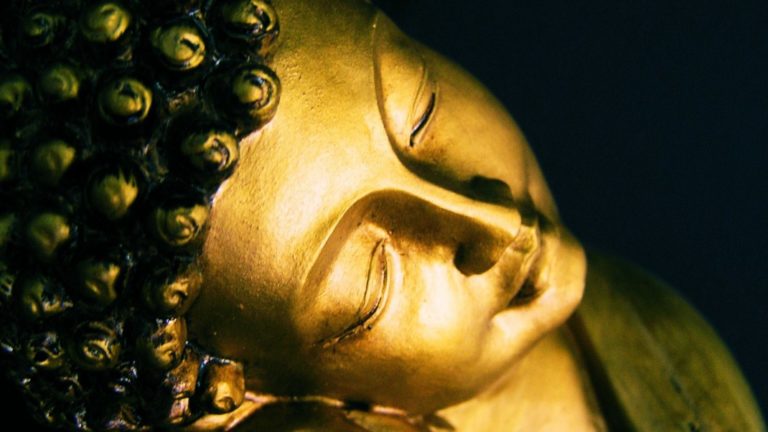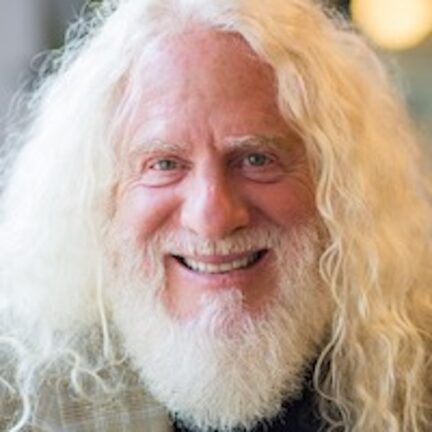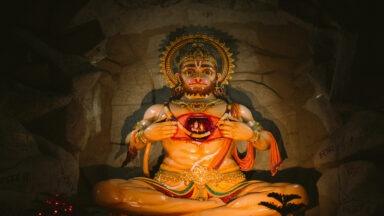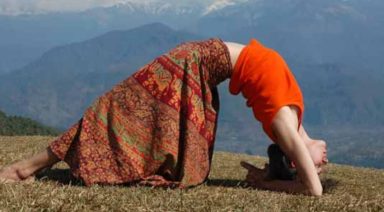What’s in a Mantra?

Most yogis know that chanting Om is chanting a mantra and that the word mantra comes from two Sanskrit words: man meaning mind; and tra meaning vehicle or instrument – a tool to transport the mind from a state of activity to one of stillness and silence. We get the words train, travel, and transportation from the Sanskrit root tra. But Om is not simply a word – it’s a seed sound known as a bija – heralding all of the unbounded universe in its very utterance. So let’s dive into the deep end of the mantra pool!
Most mantras are comprised of the fifty letters of the Sanskrit alphabet and can consist of a single letter, a syllable or string of syllables, a word, or a whole sentence. Typically, most mantras are sounds, syllables, or vibrations that don’t necessarily have a meaning. Their value lies in their vibrational quality, not in any meaning that humans, society, culture, or civilization has placed on them over the last few thousand years. For this reason they go beyond the state of human existence on this planet, and they take you deeper because they are vibrations that have existed since the dawn of creation.
The Hymn of the Universe
Om – often referred to as the hymn of the universe – is considered the ultimate vibration because it contains every vibration that has ever existed and every vibration that will ever exist. It’s pure yoga – union. Just as white light contains all the colors of the spectrum, Om contains every sound in the vibrational spectrum – even those we can’t hear with our ears. The cover of Pink Floyd’s Dark Side of the Moon represents this brilliantly as it shows the white light coming into a prism and all the colors of the spectrum coming out the other side. The same could be said for Om – it’s the white light of sound.
Historically, Om is first mentioned in the twelve verses of the ancient Vedic text the Mandukya Upanishads, which explains the three basic states of consciousness: waking, sleeping, and dreaming. In its original spelling and pronunciation, AUM (pronounced ahh-uhh-mmm) is a blending of those three states of consciousness into the one-ness of three distinct syllables: A, U, and M. These three vibrations also represent the three stages of life: birth, living, and death.
The vibration A (pronounced ahh, like the sound you make opening your mouth for the doctor) represents the waking state and the beginning of all things. The letter A is the first letter of most every alphabet, the first letter of the Rig Veda, the Koran, Homer’s Odyssey – even the New Testament! The vibration A heralds creation…the beginning. Vedic sages refer to it as the a-kara and it represents the realm of form and shape – the physical realm.
The vibration U (pronounced oo) is referred to as the u-kara and represents the dream state, the realm that is devoid of form or shape – the realms of air, water, fire, dreams – ever-changing aspects of the formless world around us.
The vibration M is known as the ma-kara, which represents the state of deep sleep – neither form or formless like the other two realms but beyond shape or shapelessness – the realm of consciousness in hibernation, waiting to unfold.
In Sanskrit grammar, when the letters A and U are combined in writing, they are translated as the letter O. That is why we so often see Om written instead of Aum. Over thousands of years, the writing of Aum has taken a back seat to Om, and that has led to Om being the sound that is most often chanted by both Western students and teachers of yoga, meditation, and Vedanta.
When the three individual vibrations are combined, a fourth vibration is created like a chord in music made up of individual notes. AUM (pronounced ahhh–uhhh–mmmm) represents the fourth state of consciousness – transcendent consciousness or turiya – what we call enlightenment or one-ness. In Vedanta, it’s the unity of the divine made up of its three components: creation; preservation; destruction (and rebirth). The chanting of this mantra heralds our universality, which is why we usually chant Om before and/or after meditation and yoga practice, and when we read sacred, ancient texts. By repeating a vibration or sound over and over, it will become part of your physiology; it will become your mind; it will become *you. * It will lose all meaning, all definition, and all relevance. There will be no separation between you and the vibration that is resonating right now.
Chanting Om (out loud or silently) is an ideal reminder of our universality.
Studies Show Mantra Repetition Has Measurable Healing Effect

New studies show that repeating sacred sounds can have a powerful effect on your health and well-being.
The practice of mantra, or the repetition of sacred sounds, has been an integral part of many spiritual traditions throughout the ages. Today, exciting new research is scientifically validating the profound psychological and physiological benefits of this ancient practice.
Dr. Shamini Jain is a leader in the emerging field of biofield science and author of “Healing Ourselves.” She knows mantra repetition to be a highly effective tool for consciousness expansion and healing.
“Sometimes we get so bogged down in the conditioned mind that we find it harder to reach our spirit,” Jain said. “So, mantra is a tool for us to reach our spirit, whether we call that ‘God,’ ‘deep consciousness,’ ‘higher self’ — there are many names for it, but it’s really a technique for transcending the mind. And it can be something that’s spoken out loud, literally like repeating a word out loud, it can also be something that we repeat silently. It can also be sung, and many traditions — almost all global traditions really — have some type of practice where they utter sacred sounds.”
In ancient traditions, the primary function of mantra was to connect with the divine.
“In these traditions, there was a deep relationship of sound with consciousness. Working with mantras in these ancient traditions, it was leading you to expand your consciousness so that you can be in better contact with divinity,“ Jain said.





































